-
 Elevator Block
Elevator Block The block (pulley) was fixed to a beam in Anthony Guiterrez's HVAC office, a Red Hook building at 133 Dwight Street that was a former Paint Factory.
-
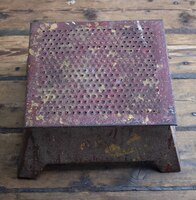 Conductor's Step Stool
Conductor's Step Stool Used by train conductors to exit and enter trains while in station.
-
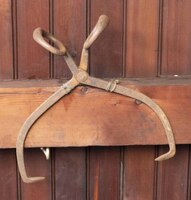 Tie Tongs
Tie Tongs Used to maneuver rail ties.
-
 Stove
Stove Stove used to burn coal to heat the living quarters on the barge.
-
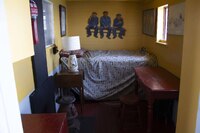 Captain's Bunk
Captain's Bunk
-
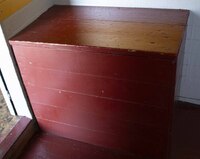 Coal Box
Coal Box Used to store fuel for the stove, which was used to heat the living quarters on the barge.
-
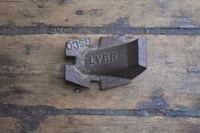 Slide Chair
Slide Chair Part of the switch machine, which is part of the moving rail of the switch slide zone. It both secures the rail and helps control its movements in the switch operations as the rail moves between sets of tracks. This one is branded LVRR for the Lehigh Valley Railroad.
-
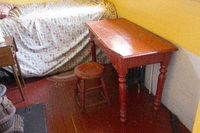 Captain's Desk
Captain's Desk
-
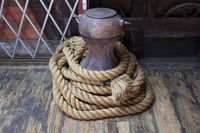 Capstan
Capstan ratcheting vertical spindle for gathering rope (like the hawser pictured around it). manually powered via handspikes
-
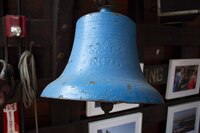 Ship's Bell
Ship's Bell This bell came from Standard Oil tanker No. 76. Among its tasks, it served to warn ships of the vessel's position in low visibility conditions.
-
 Mattress
Mattress
-
 Mark Twain
Mark Twain "Mark Twain" is a nautical term used by the leadman on a steamboat to indicate that the water was deep enough for safe travel. The mark is one fathom (six feet); mark twain is two fathoms (twelve feet).
-
 Heaving Line
Heaving Line A heaving line (or messenger line) is a relatively light rope that is tied to a larger, load-bearing line. The heaving line can be thrown a long distance and drawn up to move a heavier line, such as a hawser over a distance too far for the hawser to be thrown. The. knot at the end of this heaving line is called a monkey's fist, a large knot tied at the end of a rope to add weight, making it easier to throw from a ship to shore.
 Elevator Block The block (pulley) was fixed to a beam in Anthony Guiterrez's HVAC office, a Red Hook building at 133 Dwight Street that was a former Paint Factory.
Elevator Block The block (pulley) was fixed to a beam in Anthony Guiterrez's HVAC office, a Red Hook building at 133 Dwight Street that was a former Paint Factory. Conductor's Step Stool Used by train conductors to exit and enter trains while in station.
Conductor's Step Stool Used by train conductors to exit and enter trains while in station. Tie Tongs Used to maneuver rail ties.
Tie Tongs Used to maneuver rail ties. Stove Stove used to burn coal to heat the living quarters on the barge.
Stove Stove used to burn coal to heat the living quarters on the barge. Captain's Bunk
Captain's Bunk  Coal Box Used to store fuel for the stove, which was used to heat the living quarters on the barge.
Coal Box Used to store fuel for the stove, which was used to heat the living quarters on the barge. Slide Chair Part of the switch machine, which is part of the moving rail of the switch slide zone. It both secures the rail and helps control its movements in the switch operations as the rail moves between sets of tracks. This one is branded LVRR for the Lehigh Valley Railroad.
Slide Chair Part of the switch machine, which is part of the moving rail of the switch slide zone. It both secures the rail and helps control its movements in the switch operations as the rail moves between sets of tracks. This one is branded LVRR for the Lehigh Valley Railroad. Captain's Desk
Captain's Desk  Capstan ratcheting vertical spindle for gathering rope (like the hawser pictured around it). manually powered via handspikes
Capstan ratcheting vertical spindle for gathering rope (like the hawser pictured around it). manually powered via handspikes Ship's Bell This bell came from Standard Oil tanker No. 76. Among its tasks, it served to warn ships of the vessel's position in low visibility conditions.
Ship's Bell This bell came from Standard Oil tanker No. 76. Among its tasks, it served to warn ships of the vessel's position in low visibility conditions. Mattress
Mattress  Mark Twain "Mark Twain" is a nautical term used by the leadman on a steamboat to indicate that the water was deep enough for safe travel. The mark is one fathom (six feet); mark twain is two fathoms (twelve feet).
Mark Twain "Mark Twain" is a nautical term used by the leadman on a steamboat to indicate that the water was deep enough for safe travel. The mark is one fathom (six feet); mark twain is two fathoms (twelve feet). Heaving Line A heaving line (or messenger line) is a relatively light rope that is tied to a larger, load-bearing line. The heaving line can be thrown a long distance and drawn up to move a heavier line, such as a hawser over a distance too far for the hawser to be thrown. The. knot at the end of this heaving line is called a monkey's fist, a large knot tied at the end of a rope to add weight, making it easier to throw from a ship to shore.
Heaving Line A heaving line (or messenger line) is a relatively light rope that is tied to a larger, load-bearing line. The heaving line can be thrown a long distance and drawn up to move a heavier line, such as a hawser over a distance too far for the hawser to be thrown. The. knot at the end of this heaving line is called a monkey's fist, a large knot tied at the end of a rope to add weight, making it easier to throw from a ship to shore.